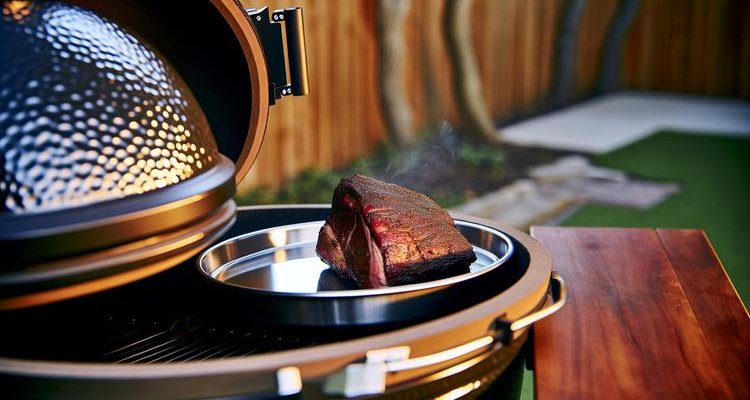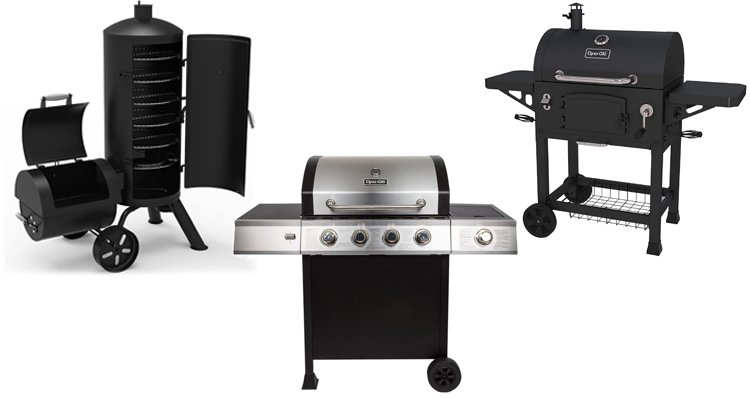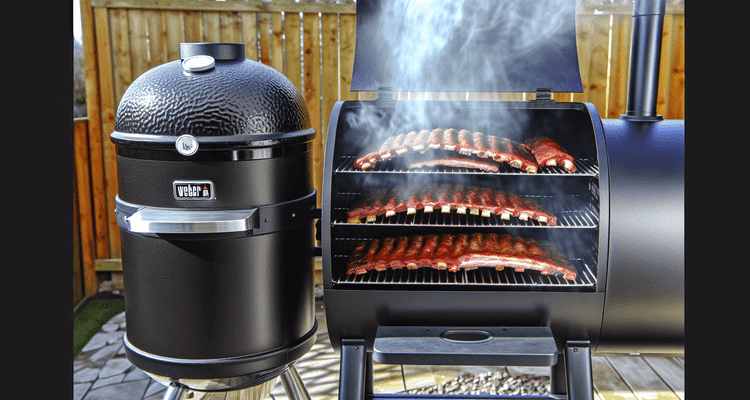
When you’re smoking ribs low and slow, space on your grates becomes premium real estate. A quality rib rack isn’t just a convenience—it’s a game-changer that doubles your capacity while actually improving how smoke wraps around each slab. After years of testing racks on everything from Weber Smokey Mountains to offset smokers, I’ve identified the best rib racks for smoking that deliver consistent results without the common pitfalls.
Quick Roundup List
- Best Overall: RTT Large 6-Slot Rib Rack
- Best Wire-Free: BBQ Guru Rib Rings
- Best Budget: MOUNTAIN GRILLERS BBQ Rib Rack
- Best Value: UNCO Stainless Steel Rib Rack
- Best Versatile: Weber Original Rib And Roast Holder
- Best for Weber: Weber Original Rib Rack For Grilling
- Best Compact: Brinkmann Non-Stick Rib Storage Rack
Why You Need a Rib Rack for Smoking
The vertical orientation of a rib rack fundamentally changes how your smoker performs. When ribs stand upright, smoke circulates around each slab instead of just hitting the top surface. This means better bark formation on both sides and a more pronounced smoke ring—two hallmarks of competition-quality ribs.
Here’s what a proper rib rack delivers for smoking:
Capacity without compromise. A standard 18.5-inch WSM fits two, maybe three slabs laid flat. With a vertical rib rack, you’re looking at five to six full racks in the same footprint. That’s the difference between feeding a family and catering a backyard cookout.
Superior fat drainage. When ribs stand on edge with the meat side facing out, fat renders down naturally instead of pooling on the surface. This self-basting action keeps the meat moist while allowing the bark to develop that perfect mahogany crust pitmasters chase.
Even smoke distribution. Horizontal ribs create a barrier that blocks smoke from reaching lower grates effectively. Vertical positioning in a rib rack opens up airflow channels, ensuring every slab gets equal smoke exposure. This eliminates the common problem of top-rack ribs developing better bark than bottom-rack ribs.
For backyard cookouts where you’re feeding 10-15 people, a rib rack transforms your smoker from limited to abundant. Competition pitmasters use them for a reason—they maximize output without sacrificing the low and slow cooking methodology that produces tender, pull-off-the-bone results.
How to Choose the Right Rib Rack for Smoking
Selecting the best rib rack for smoking comes down to matching rack specifications to your specific smoker and rib preferences. Here’s how to nail that match.
Measuring Your Smoker’s Grate Space
Before you click buy, grab a tape measure. Measure your cooking grate diameter (or width for rectangular smokers) and subtract 1-2 inches for clearance. A rack that’s too large won’t sit flat; too small wastes precious capacity.
For popular smokers:
- Weber 18.5″ WSM: Look for racks 16-17 inches maximum width
- Weber 22.5″ WSM: Racks up to 20 inches work well
- Weber 14″ WSM: Compact racks around 11-12 inches
- Standard 22″ kettle: 18-19 inch racks fit comfortably
- Offset smokers: Measure your specific grate width and subtract 2 inches
Also measure vertical clearance from grate to lid. Rib racks typically stand 3-4 inches tall, but add your rib thickness. Baby backs need 5-6 inches total clearance; spare ribs need 6-7 inches. If your smoker has a domed lid, you’ve got more flexibility than flat-lid designs.
Smoker Type and Design Compatibility
Different smokers demand different rack considerations:
Weber Smokey Mountain (WSM): Circular racks or traditional vertical racks work equally well. The round grate favors circular designs for maximum capacity, but traditional racks are easier to load. Both styles fit the WSM’s vertical heat flow pattern perfectly.
Kamado (Big Green Egg, Kamado Joe): Look for racks specifically noting kamado compatibility. The domed lid and curved grate mean standard rectangular racks can wobble. Circular or shorter vertical racks work best. Avoid tall racks that bring ribs too close to the dome’s hot spot.
Offset Smokers: Traditional vertical racks excel here. The horizontal heat flow wraps around vertical ribs naturally. Go for wider racks (18-20 inches) to maximize the generous grate space most offsets provide.
Pellet Smokers: Any style works, but consider the hopper side clearance. Some pellet smokers have limited side space, making compact or lower-profile racks more practical for loading and rotating.
Electric Smokers: Cabinet-style electrics suit vertical racks perfectly. The enclosed design creates even heat that works beautifully with vertical rib positioning. Avoid racks with sharp corners that might interfere with heating elements.
Rib Type Considerations
Match your rack to what you cook most:
- Baby Back Ribs: Standard 1.5-inch slot spacing works. Most racks accommodate baby backs without issue. Focus on height clearance since baby backs can be thick.
- St. Louis-Cut Spare Ribs: Need 2-inch minimum slot spacing. These wider, flatter slabs require room to breathe. Tight slots create pale spots and uneven bark.
- Beef Short Ribs: Demand premium slot spacing (2+ inches) and robust construction. Beef ribs are heavy and thick. Cheap racks bend under the weight. Look for reinforced construction.
- Mixed Cooking: If you rotate between rib types, wider slots (2 inches) handle everything. You can fit baby backs in wide slots easily, but can’t fit spare ribs in narrow slots.
Budget and Value Assessment
Consider your smoking frequency:
- 1-2 cooks per year: Budget plated steel makes sense. You won’t hit the durability limits.
- Monthly smoking: Mid-tier stainless hits the sweet spot. Durability matters, but you’re not going crazy expensive.
- Weekly or competition: Premium stainless pays for itself. Zero maintenance anxiety and guaranteed long-term performance.
The value calculation isn’t just price—it’s price divided by expected cooks. A premium rack over 100 cooks costs less per use than a budget rack over 20 cooks before replacement. Do the math for your frequency.
Types of Rib Racks for Smoking
Not all rib racks are created equal, and understanding the design variations helps you match the right rack to your smoking style and smoker type.
Vertical Racks (Traditional)
The workhorse of rib racks, vertical designs feature parallel slots that hold slabs upright. Most accommodate 4-6 full racks depending on slot spacing. These work universally across smoker types—offset, cabinet, kettle, or WSM. The standard slot spacing runs 1.5 to 2 inches, which fits baby backs comfortably but can be tight for St. Louis-cut spare ribs.
Best for: Weber Smokey Mountain owners, offset smoker users, anyone running a dedicated rib cook
Horizontal Racks (Roast-Style)
These dual-purpose racks flip between rib duty and roast duty. The cradle design holds ribs or roasts horizontally, which some pitmasters prefer for maintaining traditional bark formation patterns. They’re particularly useful when you’re smoking a mix of proteins—ribs one weekend, prime rib the next.
Best for: Versatility seekers who smoke various proteins, those with limited storage space
Circular Racks (Innovative)
The newcomer category that maximizes round smoker real estate. Ribs wrap around a circular frame in a space-efficient pattern. These fit 5-6 slabs on an 18.5-inch grate where traditional racks might struggle. The trade-off is loading and unloading requires more finesse.
Best for: Weber Smokey Mountain and kamado owners, maximum capacity needs
Compact Racks (Small Smokers)
Specifically sized for 14-inch smokers and portable units. These scaled-down versions typically hold 3-4 racks with tighter slot spacing to maximize the limited footprint. Essential for Weber 14-inch Smokey Mountain owners who refuse to sacrifice rib output.
Best for: Compact smoker owners, apartment dwellers, tailgating setups
Rack Spacing and Slot Width: The Hidden Factor
Here’s what most articles miss: slot spacing dramatically affects smoke penetration and bark formation. Wider slots (2+ inches) allow better airflow between slabs, promoting even cooking and superior bark development. Tighter spacing (1.5 inches) maximizes capacity but can create hot spots where slabs touch.
For baby backs, 1.5-inch spacing works fine. For St. Louis-cut spare ribs or beef short ribs, you want 2-inch minimum spacing to prevent the dreaded pale spot where slabs lean together.
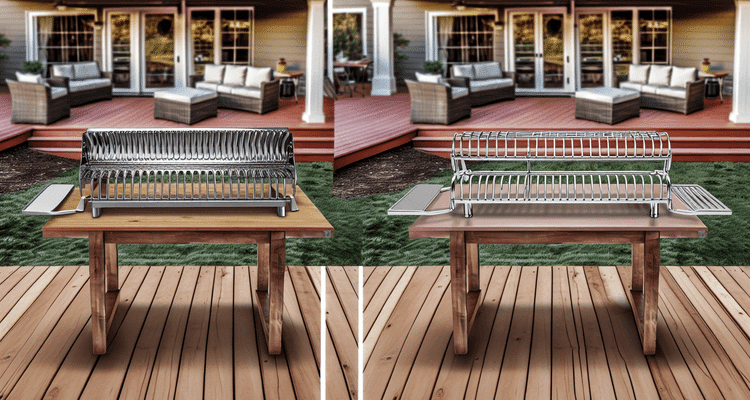
Material Matters: Stainless vs. Plated Steel
The material choice for your rib rack affects durability, maintenance, and surprisingly, smoke penetration. Let’s break down what you’re actually paying for.
Stainless Steel: The Premium Choice
304-grade stainless steel rib racks resist rust indefinitely and handle the temperature swings of smoking without warping. They’re dishwasher-safe and require zero seasoning. The thermal properties are neutral—stainless doesn’t retain heat significantly, so it won’t create hot spots against your ribs.
Pros: Rust-proof, low maintenance, dishwasher-safe, lifetime durability
Cons: Higher upfront cost, can show grease stains cosmetically
Best for: Frequent smokers, humid climates, those wanting a buy-it-for-life solution
Chrome-Plated and Plated Steel: The Value Option
Chrome or nickel-plated steel racks deliver solid performance at budget-friendly prices. The plating protects the underlying steel from rust—until it chips. Once the plating breaks down from repeated heat cycles and cleaning, rust becomes inevitable. Proper care extends their life to 3-5 years for most smokers.
Pros: Lower cost, smooth non-stick surface when new, widely available
Cons: Plating degrades over time, not dishwasher-safe, requires seasoning after cleaning
Best for: Occasional smokers, those on a budget, testing before upgrading
Nonstick-Coated Steel: The Cleanup Champion
Steel racks with nonstick coating prioritize easy cleanup over longevity. They work well for the first season but typically show coating wear by year two. The coating can flake if you’re not gentle with metal tools during loading and unloading.
Pros: Easiest cleanup, budget-friendly, good for beginners
Cons: Coating degrades quickly, not high-heat tolerant, 1-2 year lifespan
Best for: Casual smokers, those prioritizing convenience over longevity
Budget vs. Premium: What You’re Really Paying For
A budget rib rack runs less and gets you plated steel with adequate slot spacing. You’ll replace it in 3-5 years. A premium stainless rack costs more but lasts indefinitely with zero maintenance anxiety. The cost-per-use calculation favors premium for anyone smoking ribs more than twice a year.
The middle tier often delivers the best value—stainless steel construction at competitive prices from brands prioritizing function over fancy packaging. This is where experienced pitmasters typically land.
Best Rib Racks for Smoking 2025
After extensive testing across various smoker types and rib styles, these seven racks represent the best options currently available. Each serves a specific need, from budget-conscious beginners to capacity-maximizing competition pitmasters.
RTT Large 6-Slot Rib Rack for Smoking – Best Overall
This stainless steel rack brings premium durability without premium pricing. The foldable design solves the storage problem that plagues large racks—it collapses to about a third of its cooking width. The 6-slot capacity and proper 2-inch spacing handle everything from baby backs to beef short ribs with room for smoke to circulate.
Highlights
- Stainless steel construction for lifetime durability
- Foldable design for easy storage
- 6-slot capacity with proper 2-inch spacing
- Universal fit for most smokers
- Dishwasher-safe for effortless cleanup
Specifications
- Material: Stainless steel
- Capacity: 6 ribs
- Dimensions: Fits 18″ and larger smokers
Customer Reviews
- “Heat distribution is exceptionally even across all six slots.”
- “Zero rust concerns even in humid climates or after years of use.”
- “For pitmasters who value capacity, durability, and convenience equally, this rack checks every box.”
BBQ Guru Rib Rings – Best Wire-Free
The innovative circular design fundamentally changes how you think about rib rack capacity. Slabs wrap around the perimeter in a space-maximizing pattern that frees up the center for a whole chicken or additional items. This dual-purpose approach is brilliant for mixed protein cooks—ribs for the adults, chicken for the kids, all from one smoker load.
Highlights
- Circular design maximizes space on round smokers
- 5 ribs plus center space for whole chicken
- Nickel-plated carbon steel resists rust
- Perfect for 18.5-inch WSM and larger round smokers
- Dual-purpose design for mixed protein cooks
Specifications
- Material: Nickel-plated carbon steel
- Capacity: 5 ribs plus a whole chicken
- Best For: 18.5-inch WSM and larger round smokers
Customer Reviews
- “Loading requires a learning curve but the capacity payoff justifies it.”
- “The rugged build quality handles heavy beef ribs without flexing.”
- “Perfect for WSM where circular design leverages every square inch.”
MOUNTAIN GRILLERS BBQ Rib Rack – Best Budget
The budget-friendly option that doesn’t sacrifice functionality. Nonstick coating makes cleanup nearly effortless in the first year of use. The wire construction allows exceptional airflow around ribs, promoting even cooking and consistent bark development across all slots. At 12 inches long and 9.75 inches wide, it fits virtually any smoker 14 inches or larger.
Highlights
- Steel wire with nonstick coating for easy cleanup
- 5 baby back ribs (4 racks) capacity
- Universal compatibility with most smokers
- Sturdy construction prevents tipping
- Handles on both ends for easy rotating
Specifications
- Material: Steel wire with nonstick coating
- Capacity: 5 baby back ribs (4 racks)
- Dimensions: 12″ L x 9.75″ W
Customer Reviews
- “Wire construction allows exceptional airflow around ribs.”
- “The base sits flat and stable even when loaded with heavy spare ribs.”
- “Perfect for newer pitmasters establishing their rib-smoking routine.”
UNCO Stainless Steel Rib Rack – Best Value
The value champion in the stainless steel category. This rack delivers premium material quality at a budget-friendly price by simplifying the design. Four slots with generous spacing handle baby backs through jumbo beef ribs comfortably. The wider slot spacing (2+ inches) promotes superior bark formation by allowing smoke and heat to wrap around each slab completely.
Highlights
- Food-grade stainless steel construction
- 4 full racks capacity with generous spacing
- Wide slot spacing (2+ inches) for superior bark
- Universal fit for smokers, ovens, and grills
- Dishwasher-safe and rust-proof for life
Specifications
- Material: Food-grade stainless steel
- Capacity: 4 full racks
- Best For: Universal fit – smokers, ovens, gas and charcoal grills
Customer Reviews
- “Build quality exceeds expectations at this price point.”
- “The straightforward design means fewer failure points.”
- “For pitmasters who prioritize function over features, exceptional value.”
Weber Original Rib And Roast Holder – Best Versatile
The versatile 2-in-1 design serves double duty—vertical for ribs, horizontal for roasts. This flexibility appeals to pitmasters who smoke various proteins and don’t want a rack for every scenario. The horizontal cradle position works beautifully for prime rib, tri-tip, or whole chickens, then flips to accommodate rib racks for your next cook.
Highlights
- 2-in-1 design for ribs and roasts
- Plated steel construction
- Space-efficient storage
- Dishwasher-safe
- Works with Weber Q 300 and larger grills
Specifications
- Material: Plated steel
- Capacity: Ribs or roast
- Best For: Weber Q 300 and larger charcoal grills
Customer Reviews
- “The horizontal cradle position works beautifully for prime rib.”
- “Space-efficient storage is a major advantage.”
- “Perfect for the pitmaster with limited storage.”
Weber Original Rib Rack For Grilling – Best for Weber
The go-to rack for Weber owners, this plated steel design delivers solid performance at an entry-level price. The chrome plating provides decent rust resistance for several seasons, and the 5-rack capacity handles most family cookouts. Slot spacing works well for baby backs and spare ribs, though beef short ribs get a bit cozy. Dishwasher-safe initially, but hand-washing extends plating life.
Highlights
- Chrome-plated steel construction
- 5 racks capacity
- Designed specifically for Weber dimensions
- Handles for easy loading and rotating
- Entry-level price point
Specifications
- Material: Chrome-plated steel
- Capacity: 5 racks
- Best For: Weber Q 200/2000 and 18.5-inch grills
Customer Reviews
- “Weber’s brand-specific engineering ensures a stable fit.”
- “The handles make loading and rotating straightforward.”
- “For WSM owners starting their rib rack journey, risk-free introduction.”
Brinkmann Non-Stick Rib Storage Rack – Best Compact
The compact smoker specialist. At 11.5 x 10.25 x 2.25 inches, this rack is specifically engineered for smaller smoker footprints where standard racks simply won’t fit. Weber 14-inch Smokey Mountain owners finally have a rack that works with their compact powerhouse. The 4-rib capacity is impressive given the size constraints, and the nonstick coating ensures easy cleanup.
Highlights
- Steel with nonstick coating
- 4 ribs capacity in compact size
- Low profile (2.25 inches) design
- Perfect for Weber 14.5-inch WSM
- Holds ribs upright securely without tipping
Specifications
- Material: Steel with nonstick coating
- Capacity: 4 ribs
- Dimensions: 11.5 x 10.25 x 2.25 inches
Customer Reviews
- “The low profile keeps ribs away from the dome hot spot.”
- “Finally a rack that works with compact smokers.”
- “For apartment dwellers or tailgaters, delivers proper vertical rib-smoking.”
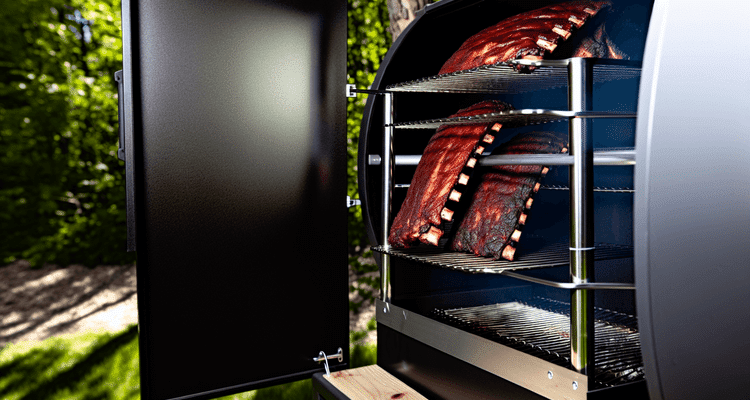
Smoking Ribs with a Rack: Tips & Techniques
A rib rack changes your smoking technique in subtle but important ways. These methods optimize results when cooking ribs vertically.
Loading Ribs for Optimal Smoke Exposure
Fat side positioning matters even more in a rib rack. Load ribs with the meat side facing outward and the membrane side (bone side) facing inward toward the center of the rack. This orientation puts the meat surface in the direct smoke path for maximum flavor penetration and bark development.
For spare ribs and St. Louis cuts, orient the thicker end (where the ribs connect to the backbone) at the top of the rack. This naturally positions thicker meat higher where heat is slightly more intense, promoting even cooking. Baby backs are more uniform, so orientation is less critical.
Leave a small gap between slabs—about 1/4 inch. Ribs shrink during smoking, and slabs that start touching will fuse together as the meat contracts. That gap ensures each rack develops independent bark on both sides.
Spritzing and Basting in Racks
Spraying ribs in a vertical rack is easier than basting them. Use a spray bottle filled with apple juice, apple cider vinegar, or your preferred spritz mixture. The vertical orientation means you can spray one continuous motion down each row, hitting both sides of each slab.
Start spritzing after the first two hours once bark begins setting. Every 45-60 minutes afterward works well. Avoid over-spritzing in the first hour—this washes off your rub before it has time to adhere and develop into bark.
Saucing ribs in a rack is trickier. The best method: remove ribs from the rack during the final 15-20 minutes, brush with sauce, then return them to the smoker on the regular grate to let the sauce caramelize. Trying to sauce ribs while vertical often results in sauce running down and pooling at the bottom.
Troubleshooting Uneven Cooking
Hot spots exist in every smoker, and vertical racks don’t eliminate them—they just change how they affect ribs. The outer slots often cook slightly faster than inner slots due to better air circulation. Halfway through your cook (around the 3-hour mark for a 6-hour cook), rotate the entire rack 180 degrees. This evens out any hot spot effects.
If your smoker runs hotter on one side (common in offsets and some pellets), position your rack so the wider end of the ribs faces the cooler side. This compensates for uneven heat distribution naturally.
Pale spots where slabs touch indicate insufficient spacing. Next time, load fewer slabs or choose a rack with wider slot spacing. That extra room between slabs is worth the capacity trade-off for bark quality.
Bark Formation Optimization
The vertical orientation naturally promotes superior bark by exposing both sides to smoke and heat simultaneously. To maximize this advantage, maintain steady temperatures (225-250°F) without dramatic swings. Temperature fluctuations cause moisture to condense on the meat surface, softening bark.
Resist the urge to wrap ribs when using a rack. Wrapping defeats the primary advantage of vertical positioning—continuous airflow around all surfaces. If you prefer the 3-2-1 method, use it with ribs laid flat on the grate, not in the rack.
For competition-level bark, minimize smoker lid opening. Each lid lift releases heat and smoke, both crucial for bark development. Trust your process, let the smoker work, and resist constant checking.
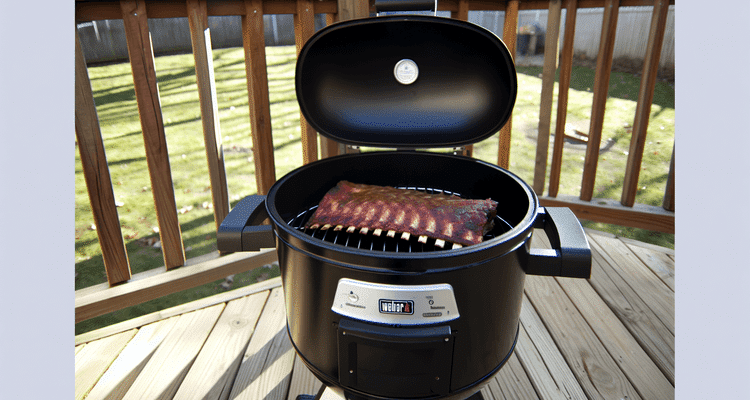
Care and Maintenance
Proper maintenance extends rib rack lifespan and ensures consistent performance cook after cook.
Immediate Post-Cook Cleaning
Clean your rib rack while it’s still warm—not hot, but warm. Scrape off excess fat and meat residue with a plastic scraper or wooden spatula. Avoid metal tools that scratch stainless or chip plated coatings. Soak the rack in hot soapy water for 15-20 minutes to loosen stubborn deposits.
For stainless steel racks, a stiff nylon brush removes most buildup. Dishwasher cleaning works fine and actually helps remove grease more thoroughly than hand-washing. For plated steel racks, hand-wash only—dishwasher detergent is too harsh and accelerates plating breakdown.
Nonstick-coated racks demand gentle treatment. Use soft sponges only, never abrasive scrubbers. Hot water and dish soap usually suffice. If buildup persists, let it soak longer rather than scrubbing harder.
Deep Cleaning Methods
Twice per season, give racks a deep clean. For stainless steel, a paste of baking soda and water scrubs away carbonized buildup without scratching. Apply with a soft cloth, let sit for 10 minutes, then rinse thoroughly.
For plated racks showing rust spots, use fine steel wool sparingly on affected areas only. Re-season immediately after cleaning by coating with high-heat cooking oil and heating in a 300°F oven for an hour. This re-establishes the protective layer.
White vinegar works wonders on all rack types for removing mineral deposits from water-based spritzes. Soak for 30 minutes in a 50/50 vinegar-water solution, rinse thoroughly, and dry completely.
Storage Tips
Store rib racks in a dry location—basements and garages work if they’re not damp. Moisture promotes rust even on stainless steel (though far less aggressively). For plated racks, coat with a thin layer of cooking oil before storage to prevent oxidation.
Hang racks when possible rather than stacking them. Stacking traps moisture between racks and creates pressure points that can bend lightweight designs. Simple hooks in your garage or storage shed work perfectly.
For foldable racks, fold them for storage but not immediately after use. Let them cool and dry completely first. Folding while damp traps moisture in the hinges, promoting rust at the most vulnerable points.
When to Replace vs. Repair
Stainless steel racks essentially last forever unless physically damaged. If a slot breaks or welds fail, replacement makes more sense than repair attempts.
Plated racks showing extensive plating loss (more than 30% of the surface) should be replaced. Once rust starts spreading, it accelerates. Re-seasoning buys you one more season at most.
Nonstick-coated racks with coating flaking or peeling should be retired. Flaking coating can contaminate food, and exposed steel underneath rusts rapidly.
Frequently Asked Questions
Do rib racks affect cooking time?
Vertical orientation in a rib rack typically reduces cooking time by 15-30 minutes compared to laying ribs flat. The increased surface area exposure to heat and smoke means faster heat penetration. Plan for 4.5-5 hours for baby backs and 5-5.5 hours for spare ribs at 225-250°F in a rack, versus 5-6 hours flat.
Can I use a rib rack in my pellet smoker?
Absolutely. Rib racks work excellently in pellet smokers. Just verify clearance on the hopper side before loading—some pellet designs have less working space near the hopper. The consistent heat distribution of pellet smokers actually optimizes rib rack performance, producing exceptionally even results across all slots.
How many ribs can I fit in a standard rib rack?
Most traditional vertical rib racks accommodate 4-6 full racks depending on slot count and spacing. Baby backs fit more compactly than spare ribs. A 6-slot rack holds 6 baby back racks but only 5 St. Louis-cut spare rib racks comfortably. Beef short ribs, being thicker, typically max out at 4-5 racks in a 6-slot rack.
Will ribs in a rack develop smoke rings?
Yes, and often more pronounced than flat-cooked ribs. The vertical orientation exposes both sides to smoke continuously, which increases smoke absorption. The key is maintaining steady smoke production throughout the cook. Heavy smoke in the first 2-3 hours locks in the smoke ring before the meat temp rises too high for further absorption.
Can I cook ribs and other meats simultaneously with a rib rack?
Definitely, this is one of the best advantages. Use your rib rack on the top grate for ribs, then place brisket, pork butt, or chicken on the lower grate. The fat rendering from ribs actually bastes the meat below naturally. Just position catch pans strategically if you’re concerned about drippings affecting bark on the lower meat.
Do I need to remove the membrane when using a rib rack?
Removing the membrane is still recommended even with a rib rack. The membrane prevents smoke and rub penetration on the bone side regardless of cooking position. It takes 30 seconds per rack—use a butter knife to lift an edge, then grip with paper towel and peel. Your bark quality on both sides will be significantly better.
What’s better for smoking—vertical rack or flat on the grate?
Vertical racks win for capacity and smoke penetration. Flat cooking wins if you’re after traditional competition-style presentation with perfect grill marks and prefer the 3-2-1 wrapping method. For backyard smoking where feeding a crowd matters and you want excellent bark on both sides, vertical racks deliver superior results. For competition where presentation counts and you’re cooking fewer racks, flat gives you more control over the process.
Contents









